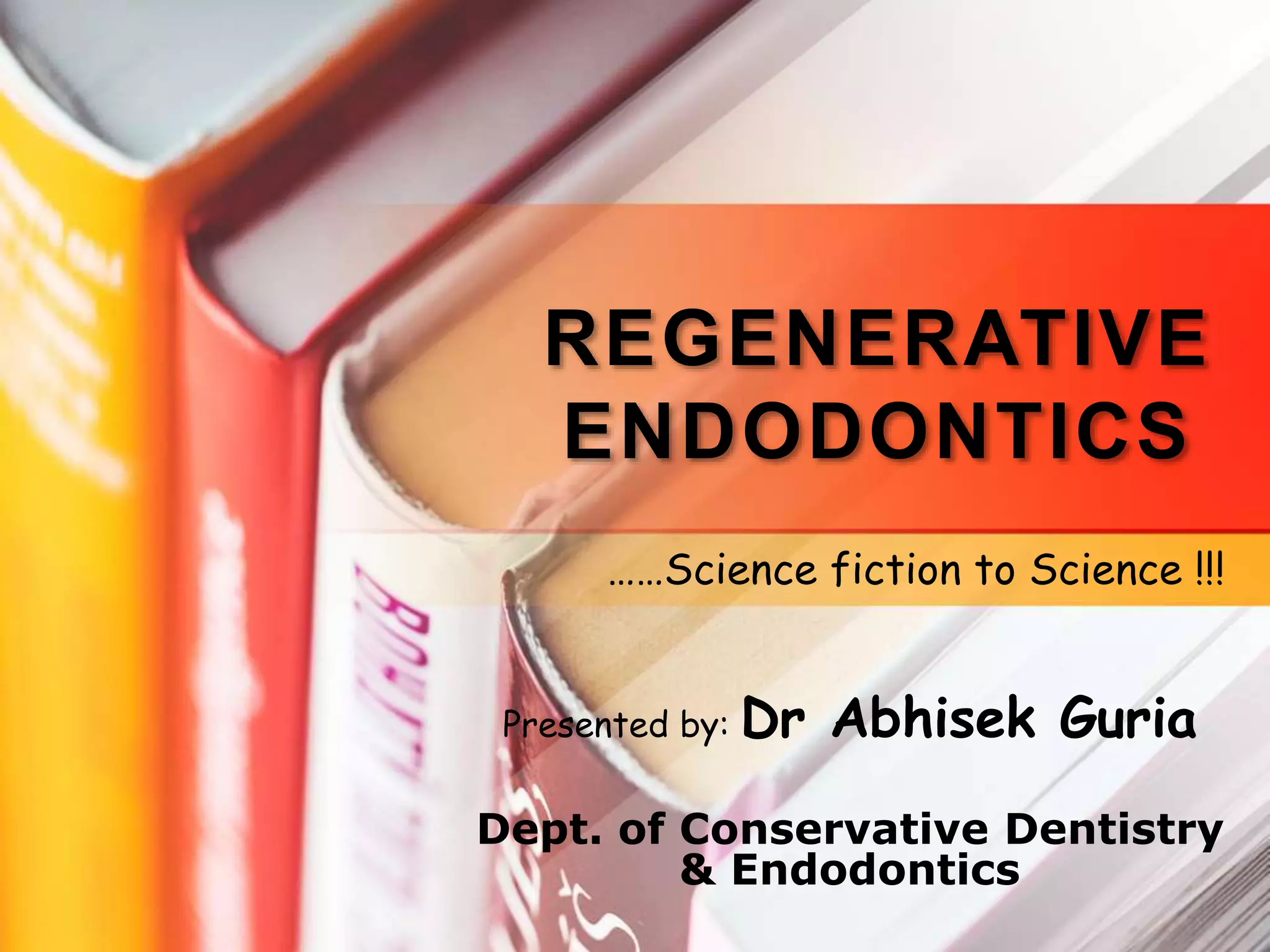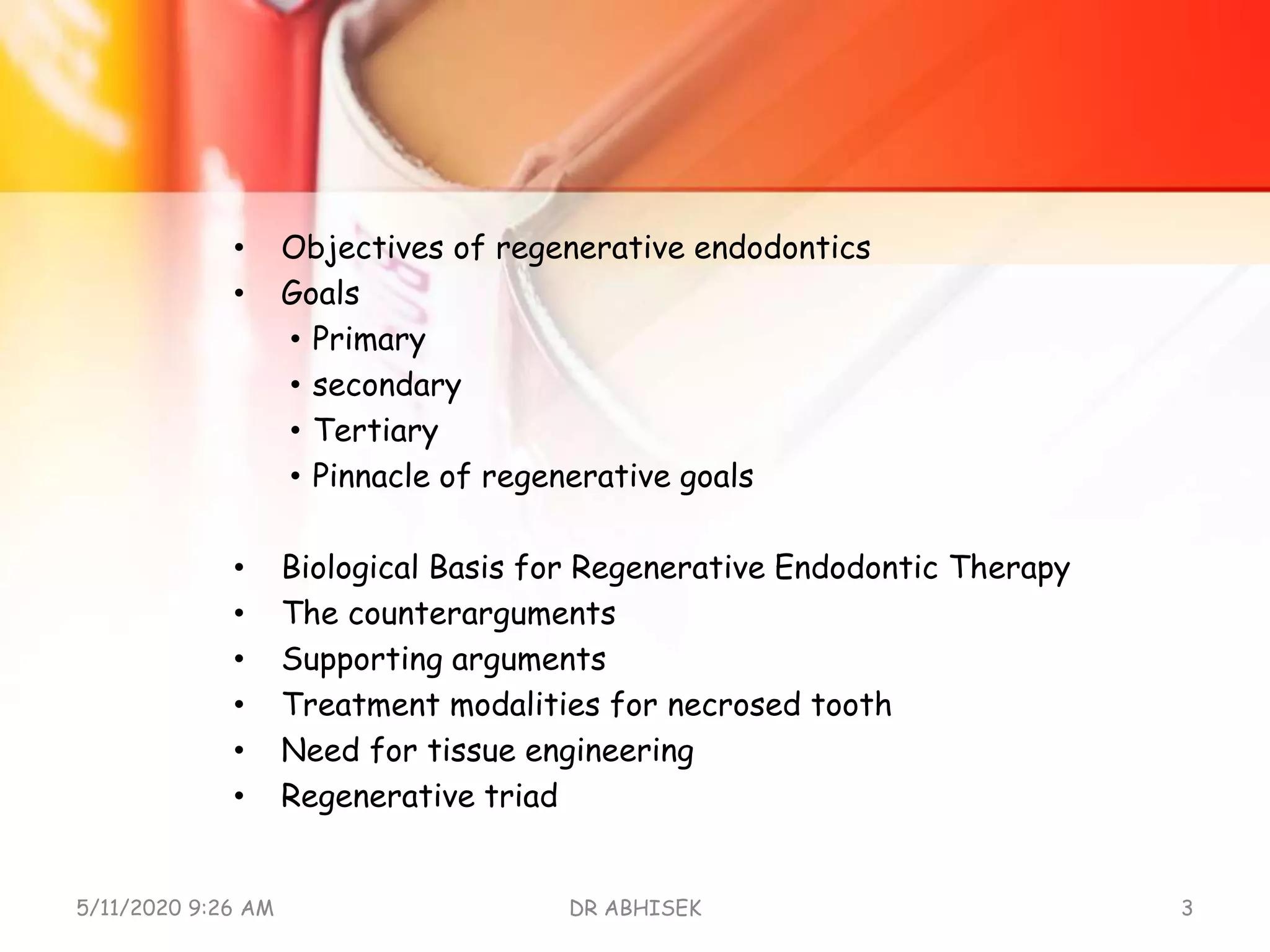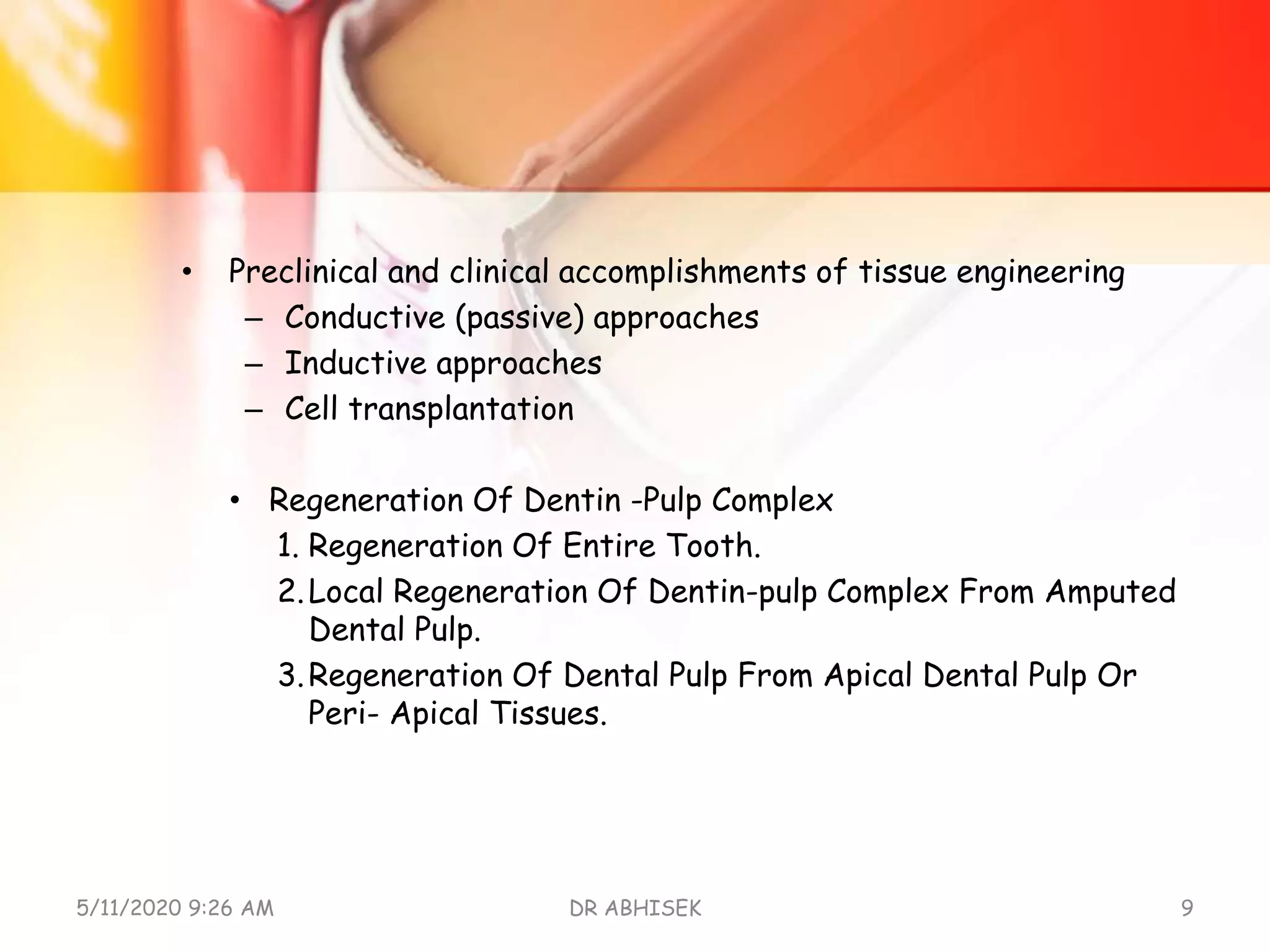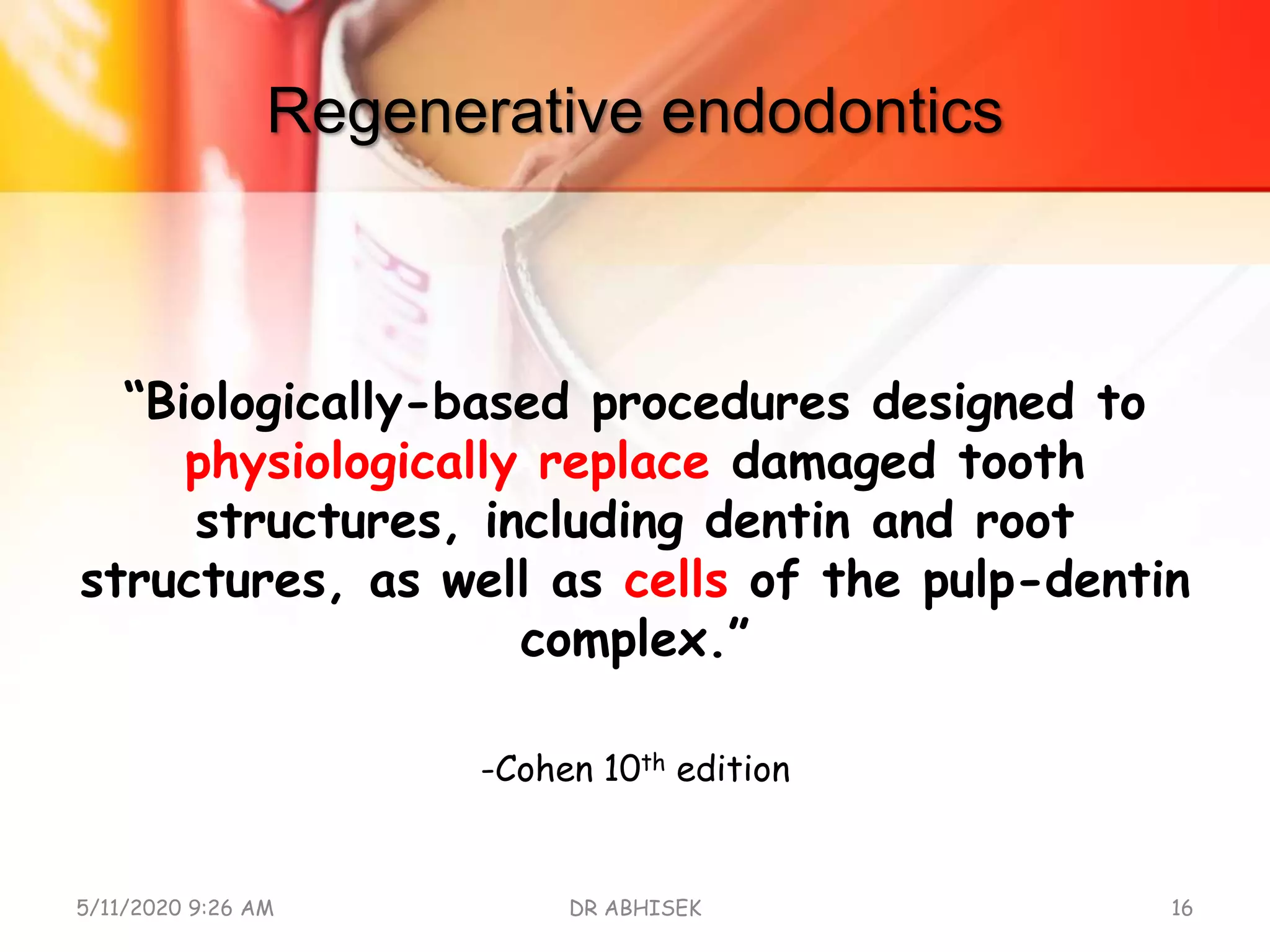This document provides an overview of regenerative endodontics and tissue engineering. It discusses definitions of key terms like regeneration, repair, and the regenerative triad of stem cells, growth factors, and scaffolds. The history and objectives of regenerative endodontics are described. Regenerative endodontic procedures aim to physiologically replace damaged tooth structures using principles of tissue engineering. This involves stimulating regeneration of the pulp-dentin complex using the building blocks of stem cells, signaling molecules, and matrices.






















































































































































![INSTRUMENTATION.
• 2 types of cells are required to achieve a normal root
development:
– odontoblasts and epithelial cells of HERS.
– They are able to resist inflammation
[N. Shah et al. 2008, A. Nosrat et al 2011]
• No instrumentation procedure remains consistent with vital stem
cells preservation
1515/11/2020 9:26 AM DR ABHISEK](https://image.slidesharecdn.com/regenerativeendodontics-200511092619/75/Regenerative-endodontics-151-2048.jpg)



![Sodium Hypochlorite
• It has a solvent action on necrotic
tissue and an antiseptic effect
• 0.5% - 5.25%.
• Cytotoxicity of sodium hypochlorite
is proportional to its concentration.
• 2.5% - best compromise between
efficiency and lack of toxicity
[M. Zehnder, 2006]
5/11/2020 9:26 AM DR ABHISEK 155](https://image.slidesharecdn.com/regenerativeendodontics-200511092619/75/Regenerative-endodontics-155-2048.jpg)


![Ethylene Diamine Tetraacetic Acid
• Better wettability of the irrigator and
a removal of the smear layer.
• 17% of EDTA is often used in cases of
bacterial infection to remove the smear
layer
• And induce a better penetration of the
irrigator and of root canal medications
[B.O. Aktener andU. Bilkay, 1993]
5/11/2020 9:26 AM DR ABHISEK 158](https://image.slidesharecdn.com/regenerativeendodontics-200511092619/75/Regenerative-endodontics-158-2048.jpg)




![• 0.01 mg/mL CaOH for canal disinfection allows
survival of 100% of the apical stem cells.
• Even at 1mg/mL, Ca(OH) give a maximal survival of
stem cells.
• At the same concentration, antibiotics paste only
allows between 33% and 56%cells survival.
[N. B. Ruparel et al 2012]
5/11/2020 9:26 AM DR ABHISEK 163](https://image.slidesharecdn.com/regenerativeendodontics-200511092619/75/Regenerative-endodontics-163-2048.jpg)
![Triple Antibiotic Paste (TAP)
• A combination of antibiotics is essential to cover a
maximum range of action.
• must be used in proper concentration for a balance
between a lower cytotoxicity against stem cells and a
maximum bacterial disinfection.
• An in vitro study has shown that a TAP concentration
of 39𝜇 g/mL would be best for application in
disinfection root canal
[S.Chuensombat, 2013]
5/11/2020 9:26 AM DR ABHISEK 164](https://image.slidesharecdn.com/regenerativeendodontics-200511092619/75/Regenerative-endodontics-164-2048.jpg)








![Limitations of TAP
1. Bacterial resistance
[sedgley CM, lee EH. Et al. 2008].
2. A risk of precipitating an allergic reaction
3. Tooth discoloration due to tetracycline
4. minocycline binds to Ca++ ions by chelation and form
insoluble complexes- discoloration
5. persistent sinus tract after using triple antibiotic
paste
Jung et al.
5/11/2020 9:26 AM DR ABHISEK 173](https://image.slidesharecdn.com/regenerativeendodontics-200511092619/75/Regenerative-endodontics-173-2048.jpg)




![THE TISSUE REGENERATION
• Through studies on animal cuts,
the apposition material-inducing
thickening of root walls may be
of different nature dentin,
cementum, or even bone
• [X.Wang et al. 2010]
• Therefore, this procedure is
not a process of pulp
revascularization but a process
of tissue regeneration.
5/11/2020 9:26 AM DR ABHISEK 178](https://image.slidesharecdn.com/regenerativeendodontics-200511092619/75/Regenerative-endodontics-178-2048.jpg)
![• The inability to obtain sections of
human teeth after revascularization is
a handicap for understanding and
validating this process.
• Only radiographic assessments of in
vivo clinical studies and laser Doppler
flowmetry can give us an idea of
treatment success.
• [H. Strobl et al. 2003].
• cold test also seems to be a good
determinant of success.
5/11/2020 9:26 AM DR ABHISEK 179](https://image.slidesharecdn.com/regenerativeendodontics-200511092619/75/Regenerative-endodontics-179-2048.jpg)







![• Even after using tissue engineering strategies,
cementum-like hard tissue was deposited on root
canal walls, and bony islands were found throughout
the root canals.
[Yamauchi N et al . 2011]
• Formation of a hard-tissue barrier inside the canals
between the coronal MTA plug and the root apex
[ Chen MY et al. 2011]
5/11/2020 9:26 AM DR ABHISEK 187](https://image.slidesharecdn.com/regenerativeendodontics-200511092619/75/Regenerative-endodontics-187-2048.jpg)





























